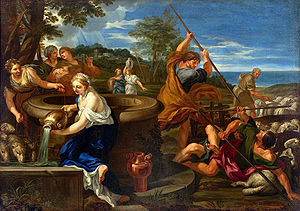Ciro Ferri

Ciro Ferri (1634 – 13 September 1689) was an Italian Baroque sculptor and painter, the chief pupil and successor of Pietro da Cortona.
He was born in
In 1670, he began the painting of the cupola of Sant'Agnese in Agone in central Rome, in a style recalling of Lanfranco's work in the dome of Sant'Andrea della Valle; but died before it was completed in 1693 by his successor Sebastiano Corbellini.
He executed also a large amount of miscellaneous designs, such as etchings and frontispieces for books; and served as an architect as well. Ferri was appointed to direct the Florentine students in Rome, and Gabbiani was one of his leading pupils. As regards style, Ferri ranks as chief of the grand manner of Cortona, also known as the
Ciro Ferri became a member of the Accademia di San Luca on 3 June 1657. His ciborium for the high altar of Santa Maria in Vallicella is a masterpieces of 17th-century bronze decorative sculpture. He continued under the patronage of the Medici, when together with the sculptor Ercole Ferrata, Ferri the painter led the Medici Academy in Rome, established in 1673 by Grand Duke Cosimo III of Tuscany. Among the pupils sent there from Florence were Anton Domenico Gabbiani, Giovanni Battista Foggini, Atanasio Bimbacci, Carlo Marcellini, and Massimiliano Soldani Benzi[3] .
Ferri was also responsible for the
He died in Rome in 1689.
References
- This article incorporates text from a publication now in the public domain: Chisholm, Hugh, ed. (1911). "Ferri, Ciro". Encyclopædia Britannica. Vol. 10 (11th ed.). Cambridge University Press. p. 287.
- Web gallery of Art biography.
- Wittkower, Rudolph (1980). Art and Architecture Italy, 1600-1750. Penguin Books. pp. 328, 330.
Notes
- ^ a b Chisholm 1911.
- ^ Hobbes, James R. (1849). Picture collector's manual adapted to the professional man, and the amateur. London: T&W Boone. p. 87.
- ^ By Giovanni Gaetano Bottari, Contributor Fratelli Pagliarini, Published 1766, Appresso Niccolò e Marco Pagliarini, Original from Oxford University Digitized Jan 31, 2007; page 190.
- ^ 17th Century Italian Drawings in the Metropolitan Museum of Art By Metropolitan Museum of Art (New York, N.Y.), Jacob Bean.
